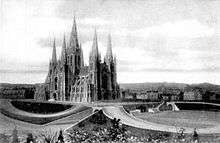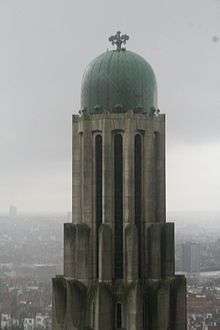Basilica of the Sacred Heart, Brussels
| National Basilica of the Sacred Heart Basilique Nationale du Sacré-Cœur (French) Nationale Basiliek van het Heilig-Hart (Dutch) | |
|---|---|
 | |
| Basic information | |
| Location | Brussels, Belgium |
| Geographic coordinates | 50°52′00″N 4°19′02″E / 50.86667°N 4.31722°ECoordinates: 50°52′00″N 4°19′02″E / 50.86667°N 4.31722°E |
| Affiliation | Roman Catholic |
| Municipality | Koekelberg |
| Year consecrated | 1935 |
| Status | Active |
| Leadership | Herman Cosijns |
| Website | www.basilique.be |
| Architectural description | |
| Architect(s) | Pierre Langerock, Albert Van Huffel, Paul Rome |
| Architectural type | Parish church, Minor Basilica |
| Architectural style | Art Deco |
| Groundbreaking | 1905 |
| Completed | 1970 |
| Specifications | |
| Direction of façade | ESE |
| Capacity | 3,500 |
| Length | 164.5 metres (540 ft) |
| Width | 107.80 metres (353.7 ft) |
| Width (nave) | 25 metres (82 ft) |
| Height (max) | 89 metres (292 ft) |
| Dome dia. (outer) | 33 metres (108 ft) |
| Materials | reinforced concrete, terracotta layering, bricks, dimension stone |
The National Basilica of the Sacred Heart (French: Basilique Nationale du Sacré-Cœur, Dutch: Nationale Basiliek van het Heilig-Hart) is a Roman Catholic Minor Basilica and parish church in Brussels, Belgium. The church was dedicated to the Sacred Heart, inspired by the Basilique du Sacré-Coeur in Paris. Symbolically King Leopold II laid the first stone of the basilica in 1905 during the celebrations of the 75th anniversary of Belgian independence. The construction was halted by the two World Wars and finished only in 1969. Belonging to the Metropolitan Archbishopric of Mechelen-Brussels, it is one of the ten largest Roman Catholic churches by area in the world.[1]
Located in the Parc Elisabeth atop the Koekelberg Hill in Brussels' Koekelberg municipality, the church is popularly known as the Koekelberg Basilica (French: Basilique de Koekelberg or Dutch: Basiliek van Koekelberg). The massive brick and concrete reinforced church features two thin towers and a green copper dome that rises 89 metres (292 ft) above the ground, dominating the northwestern skyline of Brussels.
History
In the mid-19th century, King Leopold I dreamed of turning the uninhabited Koekelberg hill into a royal residence area. After his death just before 1880, King Leopold II envisaged building a Belgian Panthéon dedicated to Great Belgians, inspired by the French Panthéon in Paris, to commemorate the 50th anniversary of Belgian independence. The King dropped this project due to the lack of enthusiasm of the Belgian population. In 1902, King Leopold II visited the Basilique du Sacré-Coeur of Paris and decided to build instead a pilgrimage church, a national sanctuary dedicated to the Sacred Heart of Jesus.[2]
Neo-gothic basilica (1905–1914)

The initial project of Leuven-based architect Pierre Langerock was a sumptuous neo-gothic church inspired by the "ideal cathedral" of Eugène Viollet-le-Duc. King Leopold II laid the first stone on 12 October 1905 during the celebrations commemorating the 75th anniversary of Belgian independence.[3] Financing the construction of the church soon became a problem.[4] Only the foundations had been finished when World War I broke out. In his pastoral letter for Christmas 1914, Cardinal Mercier gave the Basilica a new meaning:[3]
| “ | French: Aussitôt que la Paix luira sur notre pays, nous relèverons nos ruines, et nous espérons bien mettre le couronnement à cette œuvre de reconstruction en élevant sur les hauteurs de la capitale de la Belgique libre et catholique, la Basilique Nationale du Sacré-Cœur.
As soon as Peace shines on our country, we will rebuild on our ruins, and we hope to put the crowning touch on this work of reconstruction by building, on the heights of the capital of free and catholic Belgium, the National Basilica of the Sacred Heart. |
” |
Art Deco Basilica (1919–1969)
On 29 June 1919, King Albert I and a large crowd associated themselves with this promise in a ceremony on the Koekelberg Hill. However it was impossible to resume Langerock's plan due to the state of public finances. A project by architect Albert Van Huffel was adopted.
Cardinal Jozef-Ernest van Roey consecrated the unfinished church on 14 October 1935, after obtaining a special authorisation from Pope Pius XI.[5] The cupola was finished in 1969 and, on 11 November 1970, the ceremony for the 25th anniversary of the episcopate of Archbishop of Mechelen-Brussels Cardinal Leo Joseph Suenens marked the completion of the construction of the Basilica.
The final design by architect Albert Van Huffel won the great architecture prize at the Exposition Internationale des Arts Décoratifs et Industriels Modernes in Paris.[6]
Building

The church, on Koekelberg hill, is a landmark on the Brussels skyline. It is the largest building in Art Deco style in the world, at 89 m (292 ft) high and 164.5 m (540 ft) long (outside length). The cupola platform affords an excellent city panoramic view of Brussels and the wider area of Flemish-Brabant. The central nave is 141 m (463 ft) long, and at its widest the building is 107 m (351 ft). The cupola has a diameter of 33 m (108 ft). The church accommodates 3,500 people.
The building combines reinforced concrete with terracotta layering, bricks, and dimension stone. Belgian painter Anto Carte (1886–1954) designed the eight stained glass windows representing the life of Jesus.[7]
Trivia
This enormous building houses Catholic Church celebrations in both main Belgian national languages (Dutch and French), as well as conferences, exhibitions (as in 2007–2008, the International Leonardo da Vinci Expo), a restaurant, a Catholic radio station, a theatre and two museums.
Notes
- ↑ List of largest church buildings in the world
- ↑ Vandenbreeden. p. 13
- 1 2 "History of the Basilica – official website". 2008-07-07. Archived from the original on 12 February 2009. Retrieved 2009-01-10.
- ↑ Vandenbreeden. p. 17
- ↑ Stéphany, Pierre (2006). "Bruxelles. La basilique de Koekelberg". La Belgique en cent coups d'oeil (in French). Tielt: Lannoo Uitgevrij. p. 61. ISBN 2-87386-445-1.
- ↑ Pirlot, Anne-Marie (2004). "L'exposition de Paris (1925)". In Région de Bruxelles-capitale. Modernisme art déco (in French). Liège: Editions Mardaga. p. 15. ISBN 2-87009-871-5.
- ↑ Vandenbreeden, Jos; de Puydt, Raoul M (2005). "Les Vitraux". Basilique Koekelberg: monument art déco (in French and Dutch). Bruxelles: Editions Racine. p. 103. ISBN 90-209-6144-6.
See also
References
- Vandenbreeden, Jos; de Puydt, Raoul M (2005). Basilique Koekelberg: monument art déco (in French and Dutch). Bruxelles: Editions Racine. ISBN 90-209-6144-6.
- Rion, Pierre (1986). La Basilique de Koekelberg : architecture et mentalités religieuses (in French). Louvain-la-Neuve: Institut supérieur d'archéologie et d'histoire de l'art. p. 141. OCLC 15047024.
- "Catalog of images of the Basilica of the Sacred Heart". Picture Library. Royal Institute for the Study and Conservation of Belgium's Artistic Heritage. Retrieved 2009-01-10.
- Stéphany, Pierre (2006). "Bruxelles. La basilique de Koekelberg". La Belgique en cent coups d'oeil (in French). Tielt: Lanno Publishers. ISBN 2-87386-445-1.
- Pirlot, Anne-Marie (2004). "L'exposition de Paris (1925)". In Région de Bruxelles-capitale. Modernisme art déco (in French). Liège: Editions Mardaga. p. 15. ISBN 2-87009-871-5.
- Basyn, Jean-Marc; Yves Jacqmin (2000). "L'art Déco religieux". In Région de Bruxelles-capitale. Un siècle d'architecture et d'urbanisme 1900–2000 (in French). Liège: Editions Mardaga. p. 69. ISBN 2-87009-755-7.
External links
| Wikimedia Commons has media related to Basilica of the Sacred Heart, Brussels. |
- Official website of the National Basilica of the Sacred Heart
- Virtual visit of the Basilica of Koekelberg
- Discovery guide with high quality pictures of the Basilica of the Sacred Heart in Brussels